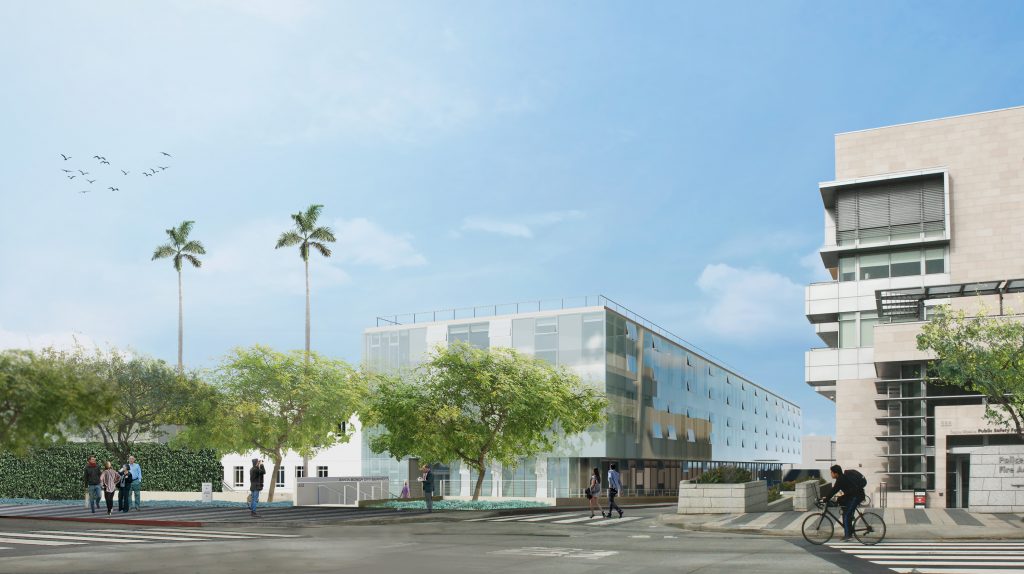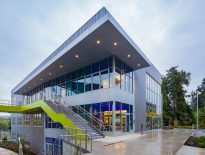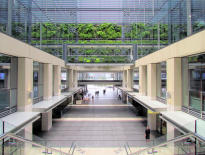Santa Monica: Committed to a Living Future
We get about 75 years on this Earth. It’s not long. Leaving this place better than we found it seems daunting these days. Very few of us are fortunate enough to be part of something special. Something that makes a dent. If you’re reading this article it’s probably because you aspire to make a dent. We need more stories about special people making an impact. I’m going to share our story about a City on a mission. The mission: show the world we can thrive while restoring our environment.
The City of Santa Monica is 8 square miles, surrounded by Los Angeles, on the beach in Southern California. Our City seal translates: fortunate people in a fortunate land. A great appreciation for the environment has persisted in this beautiful, beachside community for over a century. There is a deep-rooted culture that expects city government to reflect these values. Twenty-two years ago we became the first city in the world to publish a sustainable city plan. Since that plan, and probably before, we set bold targets and pursue them through data-driven, actionable plans. The City takes a lot of pride in this work. Blazing the trail is what we do.
Now we focus on the next frontier. Our first Living Building. Five years ago the City determined we needed a new city office building to better serve the community. It will consolidate all city services in our civic center core to provide a single hub for easy interactions with the City and be aptly named the City Services Building (CSB). As we explored sustainability targets early in conceptual design, even our Office of Sustainability staff felt Living Building Challenge might be too ambitious. At the time only 11 projects had met the challenge and none were as big as our 50,000 SF project. But as we always do in Santa Monica, we rose to the challenge. Some early sustainability charrettes revealed LBC was feasible within our budget and program requirements, as long as we were willing to take on California water regulations and commit to a whole new way of working.
And that’s where we are going. A re-imagining of the role of City government. Our City Council recently proclaimed a new value statement: a sustainable city of wellbeing. Its Foundation is three pillars (see addendum for full descriptions):
- 21st Century Governance
- The Wellbeing Index
- Sustainable City Plan
How do we modernize, improve the happiness of everyone in our city and maintain balance with our ecosystem? These are bold questions but maybe no city on earth is better suited to deliver.
The same is true for our new Living Building. Santa Monica is not a place that compromises when we know what is right. Jason McLennan, founder of the LBC, likes to ask, “what does good look like?” In the context of buildings and infrastructure, even as we’ve improved, we are still not developing in harmony with nature or wellbeing. Upon discovering the true philosophy of ILFI, we now know what good is supposed to look like. So how can we build any other way? Denis Hayes, environmental legend and owner of the Bullitt Center has said, “In any rational world, this is the future of architecture.”.
The new Santa Monica City Services Building (CSB) will be one of the greenest buildings in the world when it opens on the 50th anniversary of Earth Day in 2020. It will be the first building in California permitted to drink the rainwater that falls on its roof. The first municipal project in the country to operate with composting toilets. We will have no need for the municipal sewer system. Occupants can see the Pacific Ocean from our own irresistable stairs and know this project will never send polluted stormwater towards the coastline. In between the new CSB and our existing historic landmark City Hall will be a lush courtyard of edible plants like citrus trees, rosemary, pomegranate and echinacea, which of course are irrigated with treated greywater. This courtyard will be an outdoor room where the public can wait for an appointment at our one-stop permit center and staff can enjoy working in nature.
The all-glass facade symbolizes a transparent, 21st Century governance. Low-e coating and ceramic frit enable high-performance solar heat gain prevention. Prevailing winds off the ocean are invited into the building with operable windows automatically controlled by a weather station. For most of the year, Santa Monica has a significant diurnal shift, meaning the days are hot and the nights are cool. During these nights the building opens its windows and draws night air in, cooling the building’s exposed concrete decks. Occupants arrive to a naturally cool office that slowly emits coolth throughout the day from its thermal mass, delaying the need for active systems as the day heats up. These concrete decks also provide active heating/cooling from radiant tubing, providing efficient, uniform comfort across the floor plate. The cooling/ventilation capability of natural ventilation is enhanced by an open office concept through the building’s core.
Passive strategies promoted by technology are how Living Buildings are made. Living Buildings changing the way a City works is a new phenomenon. Our city manager envisioned a democratized, collaborative future for City staff. The opportunity to implement while helping the building meet net-zero energy prompted us to expedite this vision.
The City Services Building is for our community. For the people of Santa Monica: past, present and future. We received a $1M grant from the Bloomberg Foundation to develop new criteria for defining success in our City. Simply, are our citizens happy? This grant funded a Wellbeing division, which publishes a Wellbeing Index. Along with 21st Century Governance and the Sustainable City Plan, the Wellbeing Index drives City priorities. The CSB is a physical representation of all the City’s strategic priorities, especially Wellbeing. With LBC as the guiding framework, the building’s design sets an example for how spaces should enhance occupants’ health, happiness and wellbeing. Everyone in the building will have access to natural light, breezes off the ocean, and views of nature. The courtyard will provide a sense of community where staff and the public can pick fruit, enjoy lunch, hold meetings and enjoy sounds of the ocean. Biophilia is incorporated throughout the design, highlighted by public art installations that mimic nature and celebrate the ecology of Southern California.
Santa Monica has always prided itself on leading Southern California toward a more progressive future, a living future. We are building the CSB to save taxpayers money (approximately $10M/year from rent and utility savings) and provide more efficient services in our civic center. But we embraced the opportunity to make a global statement at our City Hall. We embraced the challenge laid out by the International Living Future Institute. If we can do this here, for a large public building, in a place that got 3” of rain when we began design, then why can’t you?
Please join us in building Living Buildings, Living Communities, Living Cities and our Living Future.
—
Addendum:
From the City of Santa Monica Framework for a Sustainable City of Wellbeing.
SUSTAINABLE CITY PLAN
In 1994, the City of Santa Monica first published its Sustainable City Plan. This strategic plan ensures that the City can continue to meet current environmental, economic, and social needs without compromising the ability of future generations to do the same. The City designed the program to help the community begin to think, plan, and act more sustainably with a focus on addressing root causes rather than symptoms.
WELLBEING INDEX
Several years later, the City received funding from the Bloomberg Foundation’s Mayor’s Challenge, to create the Wellbeing Index, designed to measure the wellbeing of residents in the community. The Index combines data we have, determines what new types of data we need to gather, and integrates in new ways all of the available information. It brings together a variety of data from City measures, an extensive resident survey and social media in six distinct yet connected categories of what research shows drives wellbeing. The Index includes a baseline for understanding what contributes to wellbeing and provides findings and recommendations on how the City and community can work to improve it.
21ST CENTURY PRINCIPLES OF GOOD GOVERNANCE
The City is approaching the new, dynamic problems of today by utilizing 21st Century Good Governance Principles. These principles involve leveraging technology, cultivating talent, understanding the bar our constituents set for us, and relying on data-based decision making to increase the effectiveness, efficiency, and equity of city services. To build a city government for the twenty-first century requires focusing on outcomes and measuring our performance in achieving them. Setting outcomes will help the City to understand what success looks like and help us to modernize the way we work and digitize services.




